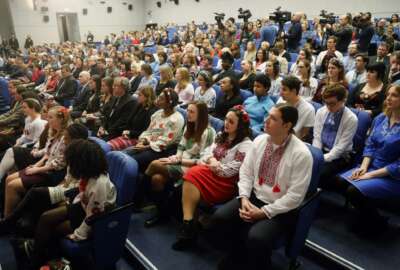
In a half century in and out of the Peace Corps, she’s done it all
In the case of the Peace Corps, Kate Raftery has been working for, with or in it for almost all of the 60 years it has been active.
Best listening experience is on Chrome, Firefox or Safari. Subscribe to Federal Drive’s daily audio interviews on Apple Podcasts or PodcastOne.
Not many people can claim association with an agency spanning nearly 50 years, but our guest can. In the case of the Peace Corps, she’s been working for, with and in it for almost all of the 60 years the Peace Corps is celebrating this year. She’s got a great title to go with that experience. Expert in the Office of the Director, Kate Raftery, joined Federal Drive with Tom Temin to discuss.
Interview transcript:
Tom Temin: Ms. Raftery, good to have you on.
Kate Raftery: Thank you very much for having me.
Tom Temin: And we should point out, you didn’t work for the Peace Corps continuously, because no one can do that. But tell us how you have been orbiting that agency for all this time.
Kate Raftery: Well, I started with Peace Corps in ’73 as a Peace Corps volunteer. And from that adventure, I then moved around to different countries providing training for new volunteers. And then I was on the staff in a variety of countries and in the headquarters. Peace Corps has a very unique personnel guidance, which is you can only work five years with Peace Corps, and then you need to leave and be out for the same amount of time that you were in. So I would leave never thinking I’d be back, and then that never worked out so well and I came back numerous times. So that’s what allowed me to have this relationship since 1973.
Tom Temin: Wow, it sounds like what the Peace Corps does aligns in some deeper level with your own values.
Kate Raftery: That’s an interesting point. Of course, everything in the rearview mirror is far clearer. My career has been woven in with service, I worked for AmeriCorps, I also worked for the International Youth Foundation, the National Park Service, so things that have an element of service. And oftentimes, the other sort of common theme has been youth. I think I’ve invested a lot of time and energy in working with young people because they tend to give me hope for the future when I don’t always see it in my own mind. So working with young people has really given me the opportunity to think that the next generation will be better. And that’s the moment now.
Tom Temin: Absolutely. And let’s talk about some topical issues. The pandemic, of course it’s affected every federal agency, because people had to telework and so forth. But Peace Corps, like State Department, is operating in many, many other countries that have been affected. What has been the effect on Peace Corps, especially on the volunteers out there?
Kate Raftery: Well, what resulted on actually March 15 decision was made to bring home all of the 7,000 volunteers that were serving across the globe. And it was one of the most challenging decisions that the agency has had to make over at 60 years of their history. And we brought 7,000 volunteers home over a course of eight days, that was a mammoth task, and really could not have been done if we hadn’t really had the relationships that we have around the world. We had folks at the community level, the family level, the ministry level, the presidential level, all saying, well if you’ve made a decision that you need Peace Corps volunteers to leave, well then we’re going to help you. We’ll drive out and pick them up, we will find flights to fly them home, because what we were facing was two things. One was the access to medical attention was getting less and less, and borders were closing moment by moment. And so we realized that if we didn’t do it at the moment that we decided to do, a very good chance that we would have had volunteers and staff stranded, if you will, in countries without medical care for what now would be a year. So all of the volunteers came home. And we fortunately had no mishaps trying to move that many people that quickly. And many of them had to quarantine away from their home. Our hope was that they could go home to their home of record, but many of them had family members that were either older or had health conditions. So we had to find places for them to quarantine, along with the fact that you mentioned, all of our staff also went home on March 13 to start working from home. And so it posed a real challenge. And I think the moment we had all of the volunteers home and accounted for, if you will, then we started to think about now what are going to be the trip wires that will say to us, now we can go back to country.
Tom Temin: And have any volunteers gone back at this point?
Kate Raftery: No, no volunteers have gone back. It’s truly a moving target. We had four countries projected for a December return, and the number of incidents in those countries then just spiked. So that had to change. And so what we’re doing now is we’re assuming that in spring, probably in June, we’ll be able to have some volunteers go back. But in actuality, we don’t believe that most volunteers will be able to return before the end of the calendar year, because it’s not really, as you can imagine, it’s not just up to us. We have 60 countries, and each one of them has a very different set of circumstances in terms of how COVID has impacted them and what they’re still dealing with.
Tom Temin: And just from an operational standpoint, people do have terms that they serve as volunteers, will this be offset so that they can do their two years?
Kate Raftery: Yes. So another decision that was made operationally was that we would close what we call close people service. So it’s not as if they’re on hold, if you will, we close their service. And we’ve gone back on a regular basis to touch base with folks to say, are you still interested in returning, either returning to your country of service that you left or returning to where you’re most needed? And at this point, we have roughly 2,000 volunteers who are sort of standing ready, if you will, to return. But we know that people have to get on with their lives. It’s now been a year that they’ve been on hold, and many of them have tried to find ways to be employed. Some of them have taken some very interesting courses actually trying to prepare themselves for returning. But we realize that the longer and longer the delay is we run the risk. But I will say we’re also very encouraged because people continue to apply, even not knowing when. I mean, in the past, you would say, well I want to be a health volunteer in Paraguay going in September. Now, people are applying to serve whenever and wherever. And in actuality, I think that’s a wonderful message that people just want to serve, particularly knowing that every country they will go to, they’re grappling with the product of COVID, just as much as we are.
Tom Temin: Sure. And looking at the bigger picture over the many decades, you’ve been associated with the Peace Corps. What have you seen in how the volunteers that sign up are, the people that apply, how has that been changing?
Kate Raftery: The demographics have changed somewhat. Initially, in the early 60s, there were far more men than women that served, that started to kind of balance out. And now for the most part, there’s always a few more women than there are men at any one time. The majority of volunteers continue to be in their early to late 20s. Although probably about six or seven years ago, we saw the increase in the number of volunteers over 50. And again, talking about the federal government here, as we see so many folks retiring, they’re retiring from their job, but they’re not done, right. And so we’ve been delighted, as have countries been delighted, when you have someone coming with 20-30-40 years of experience, they provide a whole other set of skills. So that number of volunteers over 50 has been increasing. And for us, we hope it will continue. So I think the age group, pretty much the same in terms of younger because we don’t take families, there’s always this gap. We have folks who they might be married, but they haven’t had a family yet, so they might serve earlier in life. Then when when life really happens, and families and other commitments take hold, there’ll be sort of a gap, then potentially, when folks are hitting 50 or over, or when kids are going off to college, then they might consider Peace Corps again.
Tom Temin: Sure. Now you are an expert in the Office of the Director, right now there’s an acting director, we’re sort of between administrations and so forth. When the permanent director takes his or her seat, what’s your best advice for that person?
Kate Raftery: Oh, my. Well, I guess it would be, be appreciative of the past, but challenge us for the future. I think that would be my message. Because one of the things that became very apparent during the pandemic, and the evacuation of all the volunteers is that we have this amazing relationship around the world. Peace Corps has played such a unique role in the development of countries around the world. And you find, you go and you speak with the Minister of Health and come to find out, his first teacher was a Peace Corps volunteer. And so I think there’s a need to be appreciative of the past, but I think that this is a new world. And it’s not 1961, it’s 2021. And the countries where we’re serving the people we are working with are not the folks that I worked with when I was a volunteer. Their education level might be still less than some, but they have internet, they have cell phones, they’re connected with the world. And so I think it is build on this amazing history, but challenge us to be as relevant as we could ever be going forward.
Tom Temin: Kate Raftery is an expert in the Office of the Director of the Peace Corps. Thanks so much for joining me.
Kate Raftery: My pleasure.
Copyright © 2025 Federal News Network. All rights reserved. This website is not intended for users located within the European Economic Area.
Tom Temin is host of the Federal Drive and has been providing insight on federal technology and management issues for more than 30 years.
Follow @tteminWFED
Related Stories




